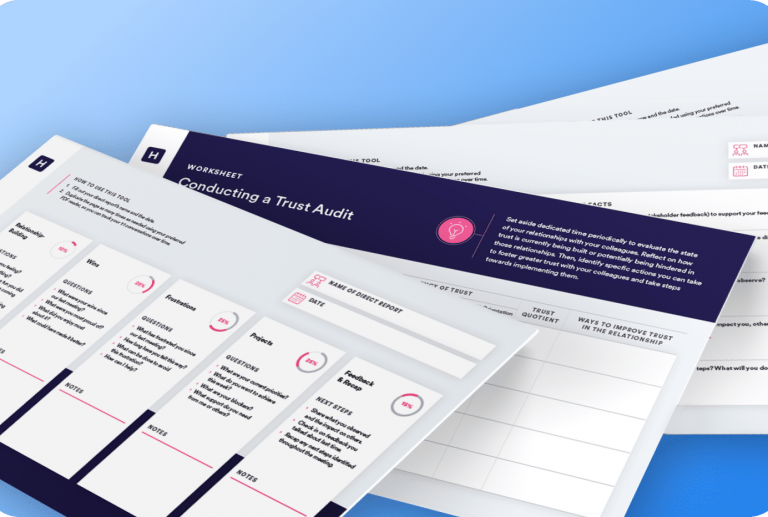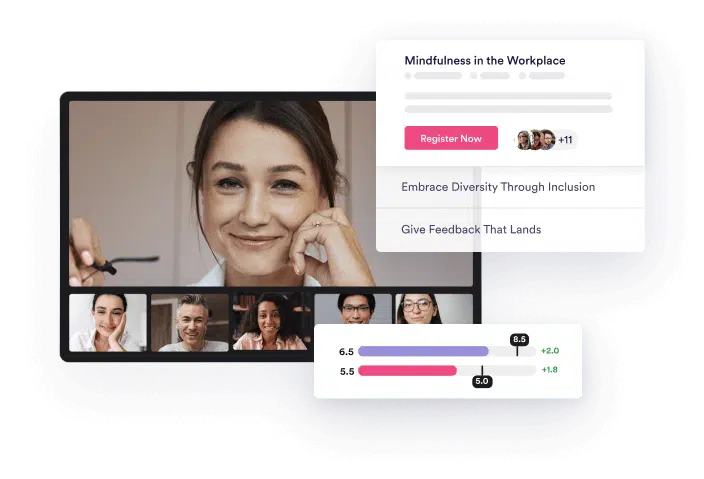What is a Retention Survey?
The definition of a retention survey refers to a tool to assess the factors that contribute to employee turnover. It is an essential instrument for understanding personnel’s attitudes and behaviors related to retention. The results can help organizations identify opportunities for improving employee retention rates.
These surveys can be administered through various methods, including online surveys, paper surveys, or one-on-one interviews. They typically include a set of questions designed to gather workers’ feedback about:
- Their level of job satisfaction
- Their perceptions of the organization’s culture and leadership
- Their intentions to stay or leave the organization.
Employers should regularly utilize retention surveys, such as annually or bi-annually, to track changes in their workforce’s perceptions and actions over time.
What is the Purpose of a Retention Survey?
Overall, the purpose of content employee retention surveys is to gather responses from company personnel about their level of job satisfaction. Then, businesses can understand and take proactive steps to address issues that negatively affect workers’ satisfaction, engagement, and loyalty. This can help to reduce turnover and improve the health of the organization.
Companies that develop initiatives and strategies to improve employees’ work experience can create a positive work environment that fosters commitment. For example, if retention survey data indicates that employees are dissatisfied with professional development opportunities, learning and development (L&D) leaders can develop targeted training programs to address this issue.
Here are some ways content employee retention surveys can help organizations.
Identify Areas of Improvement
Organizations can identify areas where they may fall short regarding employee satisfaction or engagement by gathering feedback. For example, high levels of turnover are usually the result of several factors, including:
- Poor management: Employees may leave an organization if they feel they are not receiving adequate support or leadership from their managers or supervisors.
- Lack of career development opportunities: Staff may feel unfulfilled or undervalued if they do not have opportunities to learn and grow within their roles or the organization.
- Low employee morale: Employees may become dissatisfied and disengaged if they feel undervalued, overworked, or unsupported by their organization.
- Inadequate compensation or benefits: Workers may be motivated to leave an organization if they feel they are not fairly compensated for their work or if they do not have access to good benefits and perks.
- Poor company culture: Talent may leave an organization if they do not feel a sense of belonging or do not agree with the company’s values or mission.
- Lack of work-life balance: Employees may be more likely to leave an organization if they feel that their job interferes with their personal life or cannot maintain a healthy work-life balance.
Leaders who pinpoint the underlying causes of high turnover rates and take action to address them can retain top talent and maintain a strong workforce.
Measure Employee Satisfaction and Engagement
Retention surveys can provide a snapshot of how employees feel. For example, a content employee retention survey might ask participants to rate their level of satisfaction with the following:
- Their compensation and benefits
- Their relationship with their manager
- The opportunities they have for growth and development
- The work environment
- The overall company culture.
Many content employee retention surveys include benchmarking data that allows organizations to compare their results to industry standards. Leaders can use this information to develop targeted initiatives to improve employee satisfaction and engagement.
Reduce Turnover
Understanding the factors that contribute to employee turnover helps organizational leaders take steps to address these issues and improve retention rates. This can help to reduce the costs and disruptions associated with employee turnover.
For instance, if the survey results show that top talent voluntarily leaves because they are dissatisfied with their compensation, the organization may increase salaries. Likewise, a business may offer more training and development opportunities if workers leave because they do not feel they have growth and development opportunities.
Improve the Employee Experience
Content employee retention surveys can help organizations better understand their workers’ needs and preferences, informing employee benefits, compensation, and work-life balance decisions.
One effective way to improve the employee experience is by implementing flexible work arrangements, such as telecommuting, flexible schedules, or compressed workweeks. By offering these options, staff members have more control over their work-life balance, increasing job satisfaction, reducing stress, and improving productivity.
Why is Feedback Important for Retention?
Feedback helps employees to feel valued, engaged, and invested in their work. Regular input from managers and supervisors provides team members with a clear understanding of their performance, what they are doing well, and where they can improve. This can help them to feel more connected to their work and the organization as a whole.
Here are some ways that feedback can contribute to employee retention:
- Increases engagement: Regular input from leaders can increase employee engagement by clearly understanding how their work contributes to the organization’s goals and objectives. This can help employees to feel more invested in their work and to see how their contributions are making a difference.
- Helps to identify areas for improvement: Critique and praise guides employees to identify areas where they can improve their performance. By addressing these areas, employees can feel more confident in their abilities and more committed to their work.
- Builds trust: When direct reports receive regular supervisor feedback, it can help build trust and strengthen the employee-manager relationship. This can lead to a more positive work environment where employees feel supported and valued.
- Encourages open communication: Feedback can promote open communication between employees and their managers, leading to a more collaborative and productive work environment. In addition, employees who feel comfortable sharing their thoughts and ideas are more likely to feel engaged and committed to their work.
Feedback is critical for employee retention because it helps build engagement, trust, and communication between employees and their managers. In addition, by providing regular feedback, organizations can help to create a positive work environment that nurtures dedication and allegiance among employees.
How Do You Implement Employee Retention Surveys?
Organizations can implement effective content employee retention surveys that provide meaningful insights into employee attitudes and behaviors with careful planning and execution. Below are some steps to consider:
1. Determine the survey objectives.
Define the specific objectives of the content employee retention survey, such as identifying factors that contribute to turnover, assessing employee satisfaction and engagement, or evaluating the effectiveness of retention strategies.
2. Choose a survey design.
Determine the type of survey design, such as online surveys, paper surveys, or in-person interviews. Choose a design appropriate for the organization’s size and complexity and can provide actionable data.
3. Develop the survey questions.
Develop a set of questions relevant to the survey objectives and can provide meaningful insights into employee attitudes, opinions, and behaviors. Questions should be clear, concise, and easy to understand.
4. Establish a survey schedule.
Determine the survey frequency, such as quarterly, bi-annually, or annually. This will depend on the needs of the organization and the frequency of changes to the work environment.
5. Administer the survey.
Administer the survey to employees to maximize participation and ensure anonymity. Consider using incentives to encourage participation.
6. Analyze the results.
Analyze the survey results to identify key themes and trends. Use this information to identify areas of strength and weakness and to develop targeted retention strategies.
7. Communicate the results.
Open communication demonstrates a commitment to improving employee engagement and retention. It’s essential to share retention survey results with employees and managers to build trust and transparency. Likewise, provide feedback on what areas the organization will address and how the data will be used.
8. Develop retention strategies.
Develop retention strategies based on the survey results. These strategies may include compensation and benefits changes, work environment improvements, and targeted employee development initiatives.
12 Retention Survey Questions to Ask Employees
Employers should design surveys to gather feedback on key factors contributing to employee engagement and retention. By analyzing the responses, leaders can develop targeted retention strategies that address specific needs. So, questions must identify administrative areas of strength and weakness.
The intention of the below content employee retention survey questions is to gather employees’ feedback about their perceptions and intentions.
- Overall job satisfaction: On a scale of 1 to 10, how satisfied are you with your job?
- Work environment: Do you feel the work environment is conducive to productivity and collaboration?
- Manager relationship: How would you rate your relationship with your direct manager?
- Opportunities for growth and development: Do you feel you have adequate learning and career development opportunities? Or, have you received adequate training and development opportunities to perform your job effectively?
- Compensation and benefits: Are you satisfied with your current compensation and benefits package?
- Company culture: Do you feel a sense of belonging and connection to the organization’s culture and values?
- Work-life balance: Do you feel that you have a healthy work-life balance?
- Job security: Do you feel that your job is secure and you have opportunities for advancement within the organization?
- Employee engagement: On a scale of 1 to 10, how engaged do you feel in your work and the organization’s mission? Or, what improvements would you suggest to improve employee engagement?
- Recognition and rewards: Do you feel that the organization recognizes and appreciates your contributions?
- Job fit: Do you feel that your skills and abilities are being fully utilized in your current role?
- Workload: Do you feel your workload is manageable and that you have the resources to perform your job effectively?
4 Questions to Ask Employees About the Company
Questions can also help organizations to gain insights into employee opinions of the company as a whole. For example, businesses can learn how employees view their strengths and weaknesses, align with their mission and values, and communicate effectively.
Here are four questions that organizations can ask employees about the company:
1. What do you think are the company’s strengths and weaknesses?
Asking employees to identify the company’s strengths can help to reinforce positive aspects of the workplace and to identify areas where the organization is performing well. This can help to build employee morale and engagement and to foster a positive work environment.
Conversely, weaknesses indicate where organizations can develop. For example, suppose employees consistently view compensation and benefits as a weakness. In that case, the organization may need to review and adjust its compensation and benefits package to remain competitive.
2. How well do you feel the company is aligned with its mission and values?
Asking employees about the company’s alignment with its mission and values can also help ensure the organization is living up to its stated values and goals. If employees do not feel that the company is aligned with its mission and values, it may be a sign that the organization needs to re-evaluate them and take steps to better align its practices with its stated purpose and goals.
Likewise, companies may ask if their staff understands the mission and values. Some employers may need to convey their core purpose and beliefs.
3. How effective is the company at communicating with its employees?
When employees feel that the organization is communicating effectively, they are more likely to feel engaged and committed to their work and better understand how their work contributes to the organization’s success.
Conversely, if employees consistently view communication as a weakness, they may not have the information they need to perform their jobs effectively and make informed decisions. Additionally, they may feel disconnected from the company’s goals and objectives. This can lead to decreased engagement, decreased productivity, and increased turnover.
The organization may need to improve communication channels to ensure employees receive timely and relevant information.
4. How likely are you to recommend the company as a great place to work to your friends and family?
The final question can gauge employee loyalty and advocacy. Employee recommendations can significantly impact recruitment, retention efforts, and building a positive employer brand. When employees recommend their company as a great workplace, it can help develop the organization’s reputation as an employer of choice to attract and retain high-performing candidates.
Other questions organizations may include on surveys:
- How satisfied are you with the company’s culture and work environment?
- Do you feel that the company values and respects diversity and inclusion?
- Do you feel the company is innovative and stays ahead of industry trends?
- Do you think that the company is committed to sustainability and ethical practices?
- How well does the company handle conflicts and disagreements among employees?
- How would you rate the company’s reputation and image in the industry and community?
- Do you feel that the company takes employee feedback and suggestions seriously?
These are just a few questions to ask employees about the company. It’s essential to tailor the questions to fit the specific needs and goals of the organization and to ensure that they are clear and concise to encourage honest and accurate feedback.









